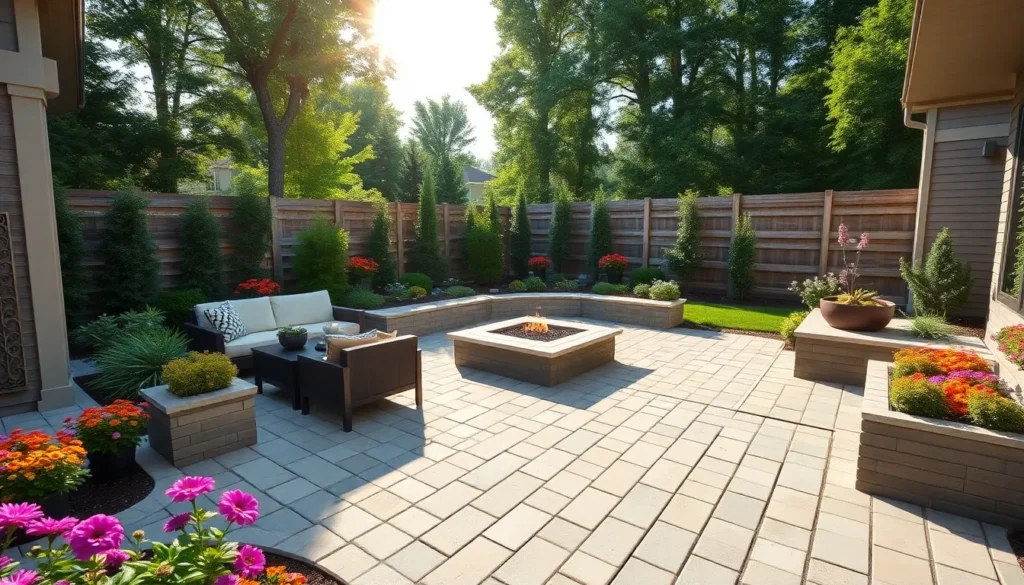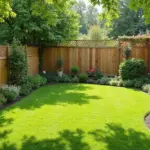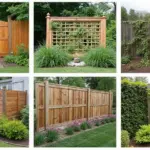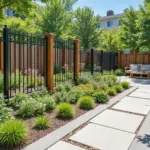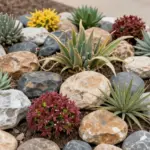We’ve all dreamed of that perfect outdoor space where summer barbecues come alive and evening conversations flow effortlessly under the stars. A well-designed paver patio transforms your backyard from ordinary to extraordinary – creating the ideal foundation for countless memories with family and friends.
Paver patios offer incredible versatility that concrete simply can’t match. Whether you’re drawn to classic brick patterns, modern geometric designs, or rustic natural stone looks, there’s a paver style that’ll perfectly complement your home’s architecture. The best part? You can customize everything from color combinations to layout patterns to create a truly unique outdoor living space.
Ready to turn your backyard dreams into reality? We’ll walk you through stunning paver patio ideas that’ll inspire your next outdoor project. From budget-friendly DIY options to luxurious entertainment spaces, these creative designs prove that your perfect patio is just a few pavers away.
Classic Brick Paver Patterns for Timeless Appeal
Classic brick pavers deliver enduring beauty that complements any architectural style. These traditional patterns create sophisticated outdoor spaces that stand the test of time.
Herringbone Layout for Visual Interest
Herringbone patterns create stunning visual drama through their distinctive zigzag arrangement. We arrange rectangular pavers at 45-degree or 90-degree angles to form interlocking V-shaped rows that draw the eye across the entire patio surface. This classic layout works exceptionally well in high-traffic areas because the interlocking design distributes weight evenly and prevents individual pavers from shifting.
Installing herringbone requires precise measurements and careful planning. We recommend starting from the center of your patio space and working outward to ensure symmetrical placement. The 45-degree herringbone creates more ever-changing movement, while the 90-degree version offers a cleaner, more structured appearance that pairs beautifully with traditional home styles.
Maintenance becomes simpler with herringbone patterns due to their tight interlocking structure. We find that weeds have difficulty growing between properly installed herringbone pavers, and the pattern naturally guides water runoff away from the patio surface.
Running Bond Pattern for Simple Elegance
Running bond patterns deliver understated sophistication through their straightforward brick-like arrangement. We offset each row by half a paver length, creating the same pattern you’d see on traditional brick walls. This timeless design works particularly well for rectangular patios and creates clean sight lines that make spaces appear larger.
Cost effectiveness makes running bond an excellent choice for budget-conscious homeowners. We can complete installations faster than complex patterns because the straightforward layout requires fewer cuts and adjustments. The pattern also uses materials efficiently, resulting in minimal waste during installation.
Versatility allows running bond to complement both modern and traditional home designs. We often recommend this pattern for homeowners who want classic appeal without overwhelming visual complexity. The simple lines create an elegant backdrop for outdoor furniture and landscaping elements.
Basket Weave Design for Traditional Charm
Basket weave patterns recreate the appearance of woven baskets through alternating rectangular blocks. We arrange pairs of pavers in perpendicular directions, creating square modules that repeat across the patio surface. This traditional design adds texture and visual interest while maintaining a sense of order and balance.
Durability improves with basket weave installations because the pattern distributes stress across multiple pavers. We find that this design handles temperature changes and ground movement better than linear patterns. The alternating grain direction also helps prevent long crack lines from forming across the patio surface.
Customization options make basket weave suitable for various patio sizes and shapes. We can adjust the module size by using different paver dimensions or creating larger blocks with multiple pavers. This flexibility allows us to create proportional designs that look appropriate whether you’re building a small intimate space or a large entertaining area.
Modern Geometric Paver Designs for Contemporary Homes
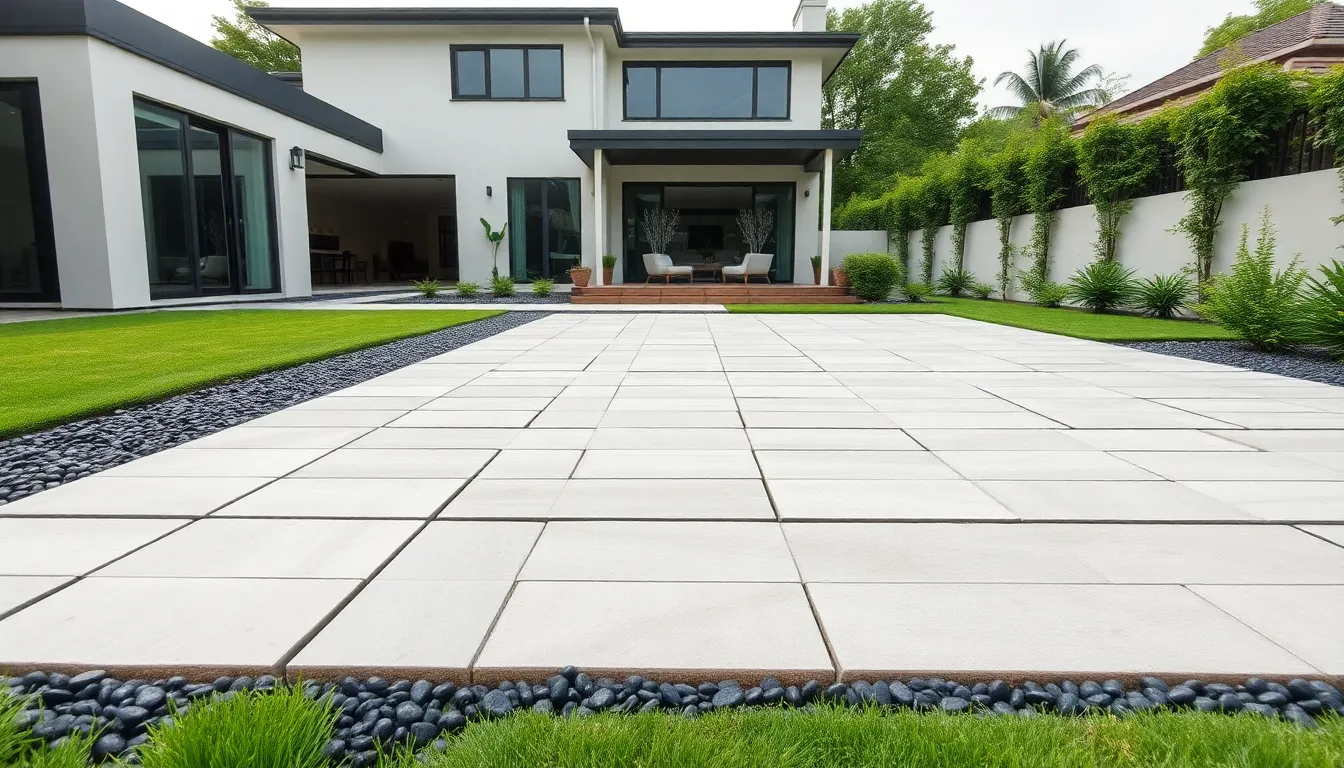
Contemporary paver designs shift from traditional patterns to embrace clean lines and structured geometry. These modern approaches create striking outdoor spaces that complement today’s architectural styles.
Large Format Rectangle Pavers
Large rectangular pavers deliver a minimalist aesthetic that transforms patios into sleek outdoor extensions of your home. We see these formats creating fewer grout lines, which enhances the clean, uninterrupted look that modern design demands.
Benefits of large format rectangles include:
- Streamlined appearance with reduced visual clutter
- Enhanced structural stability due to modular design
- Better resistance to freeze-thaw cycles compared to smaller units
- Faster installation process with fewer individual pieces
Linear arrangements work exceptionally well with these oversized rectangles. Positioning them in straight rows emphasizes their inherent geometric properties while maintaining that coveted contemporary feel. Black pebble accents between pavers can amplify this orderly, sophisticated effect.
Grid layouts offer another compelling option for large format rectangles. We recommend this approach when you want maximum visual impact with minimal complexity. The resulting pattern creates a bold, architectural statement that pairs beautifully with modern home exteriors.
Mixed Size Geometric Patterns
Mixed size patterns combine different paver dimensions to create complex, visually captivating surfaces that maintain geometric precision. We use this technique to add depth and interest while preserving the clean aesthetic modern design requires.
Popular mixed size combinations include:
- Large rectangles paired with square accents
- Hexagonal shapes integrated with rectangular strips
- Modular units arranged in interlocking formations
- Basketweave patterns using contrasting paver sizes
Basketweave designs particularly shine when executed with mixed dimensions. Alternating large and small rectangular pavers in a weave-like pattern creates visual texture without sacrificing contemporary appeal. Charcoal grout lines between contrasting paver tones amplify this sophisticated effect.
Hexagonal pavers mixed with rectangular strips offer another ever-changing approach. We often pair these with grass strips or contrasting grout to create striking geometric focal points. This combination works especially well around pool areas or as transition zones between different outdoor spaces.
Linear Strip Layouts
Linear strip arrangements emphasize the straight edges and clean geometry that define modern paver design. We align rectangular pavers in parallel strips to create orderly, contemporary patterns that complement architectural elements.
Effective linear strip techniques:
- Parallel rows running perpendicular to the house
- Alternating strip widths for added visual interest
- Integration of contrasting materials between strips
- Incorporation of industry elements like grass or gravel
Strip layouts work particularly well with large format pavers because they highlight the pavers’ inherent proportions. We recommend varying the strip widths slightly to avoid monotony while maintaining the overall geometric theme. Gray and tan pavers excel in these arrangements, providing warmth while preserving the sleek modern aesthetic.
Accent materials between strips enhance the linear effect significantly. Consider incorporating black pebbles, decorative gravel, or even grass strips to break up expanses of paving while reinforcing the geometric pattern. These elements create visual breathing room and add textural contrast to the hardscape design.
Curved and Circular Paver Patio Configurations
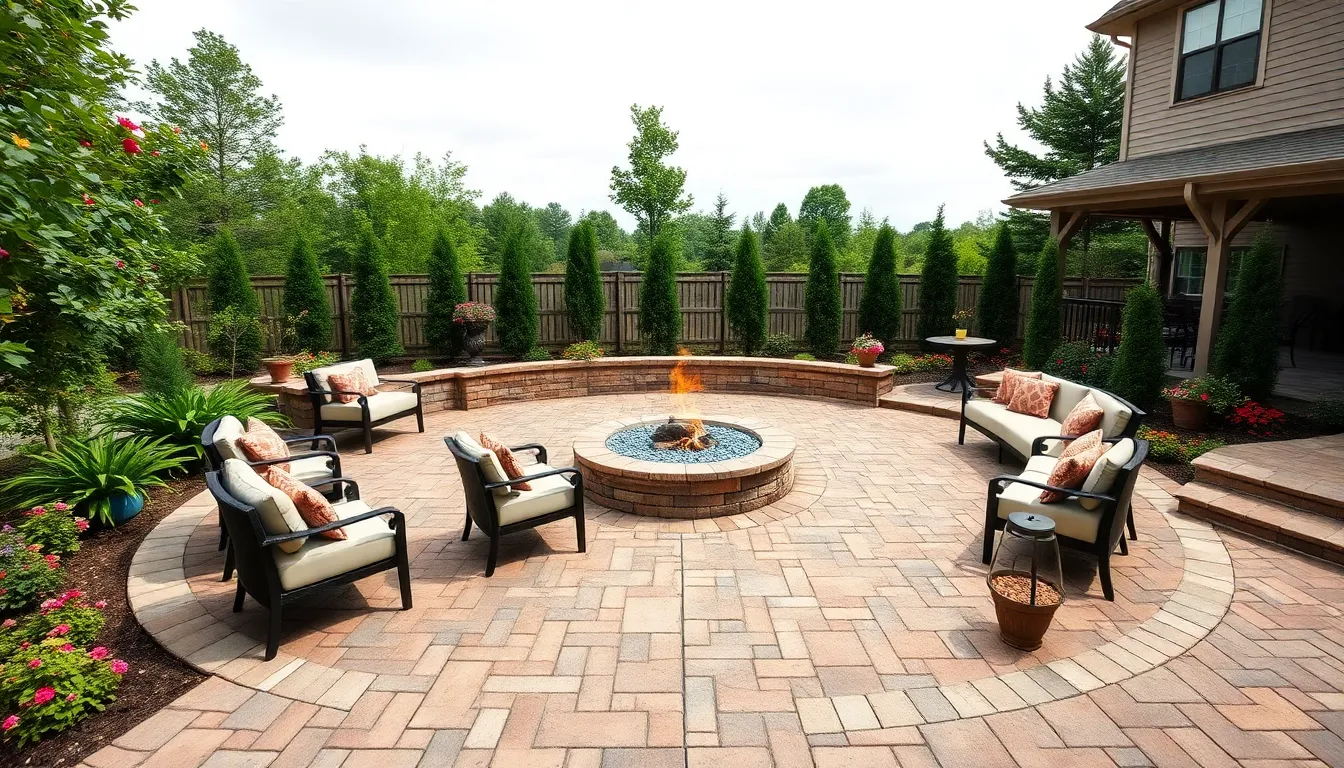
Moving beyond angular layouts, curved and circular paver configurations introduce organic flow that softens hardscape elements. These designs create visual contrast against the structured geometric patterns we’ve explored.
Sweeping Curved Edges
Sweeping curves transform ordinary patio borders into graceful industry features that flow naturally with your backyard’s contours. These organic edges break up the monotony of straight lines while creating smooth transitions between different outdoor zones. Garden beds benefit from curved paver borders that outline planting areas and establish natural walkways throughout your space.
Visual impact increases when you combine various paver colors and shapes along these sweeping edges. The curves make your patio feel larger and more inviting by drawing the eye in gentle arcs rather than sharp angles. Surrounding greenery complements these soft borders beautifully, creating seamless integration between hardscape and industry elements.
Full Circle Patio Designs
Full circle patios serve as bold focal points that command attention in any backyard setting. These standalone designs work exceptionally well for fire pit areas or round dining spaces where conversation flows naturally from all directions. Social gatherings benefit from the circular layout since everyone faces toward the center, promoting intimate connections.
Construction typically involves laying interlocking pavers in concentric circles or radial patterns that radiate outward from the center. Contrasting border pavers accentuate the circular shape while providing visual definition. The cozy atmosphere these designs create makes them perfect for evening entertainment or quiet morning coffee rituals.
Semi-Circle Accent Areas
Semi-circle sections function as versatile accent zones that frame exact garden features without creating harsh divisions. These partial circles excel at highlighting fountains, benches, or flower beds while maintaining open flow throughout your outdoor space. Transitional areas between rectangular patios and garden zones particularly benefit from semi-circular treatments.
Functional separation occurs naturally with these designs, creating distinct zones for different activities while preserving visual continuity. Contrasting border pavers effectively highlight the semi-circular shapes, making them stand out as intentional design elements. The versatility allows you to incorporate multiple semi-circles throughout your backyard to create a cohesive yet varied industry.
Multi-Level Paver Patio Ideas for Sloped Yards
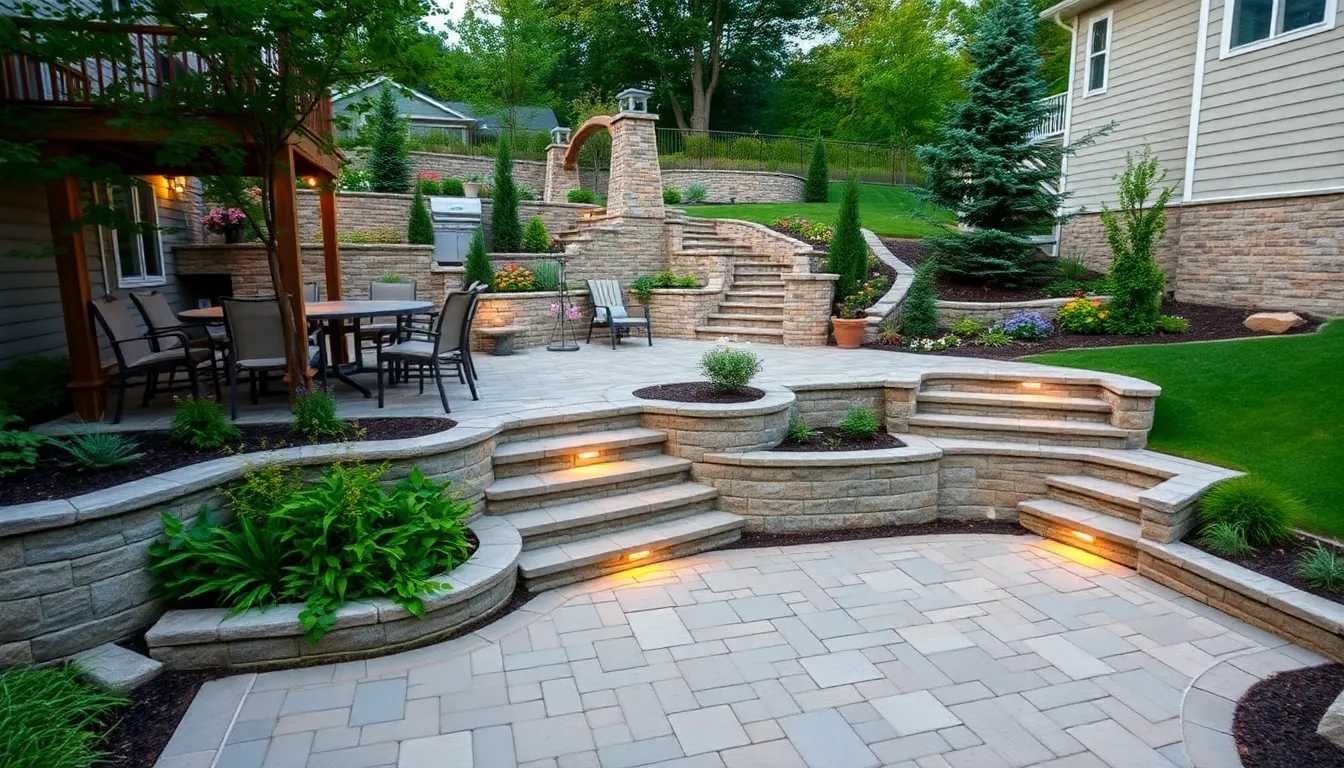
Sloped backyards present unique opportunities to create stunning multi level paver patios that maximize both function and visual appeal. We’ll explore design strategies that transform challenging terrain into sophisticated outdoor living spaces.
Terraced Patio Sections
Terraced patio sections create multiple flat areas at different elevations, connected by retaining walls or steps that maximize usable space on sloped terrain. We design these sections to function as distinct outdoor “rooms” where each level serves a exact purpose. Dining areas work beautifully on upper terraces while lounging spaces can occupy lower levels, optimizing the natural terrain for varied activities.
Retaining walls provide structural support while doubling as seating walls that add extra functionality and define space boundaries. We recommend using these walls to create intimate gathering spots and establish clear zones throughout the terraced design. Each terrace becomes a charming outdoor room that flows naturally into the next level.
Raised Platform Areas
Raised platform areas use retaining walls or elevated paver beds to create standout zones that command attention and provide excellent backyard views. We position outdoor kitchens, grill islands, or dining sets on these elevated surfaces to establish focal points throughout the space. The vertical contrast between platforms adds important architectural interest to the overall industry design.
Building these platforms allows us to highlight exact functions while creating natural gathering spots for entertaining guests. We often incorporate non slip, barefoot friendly pavers for safety, especially when children or elderly family members will use these elevated areas. These raised sections become premium zones that enhance the backyard’s functionality and visual hierarchy.
Step-Down Transitions
Step down transitions create smooth, safe navigational flow between different patio levels using pavers or natural stone construction. We design these connecting elements to encourage movement and interaction between various patio zones, such as linking a fire pit area on a lower level to an upper dining space. The layered design approach enhances both safety and aesthetic appeal.
Integrated lighting in stairs and walls provides both safety features and evening ambiance that extends usable hours. We select colors and textures that harmonize with the home’s exterior and backyard environment to create cohesive visual flow. Vertical elements like planters, pillars, or garden walls complement the layered structure while maintaining elegant design continuity throughout the multi level space.
Paver Material Options to Enhance Your Backyard
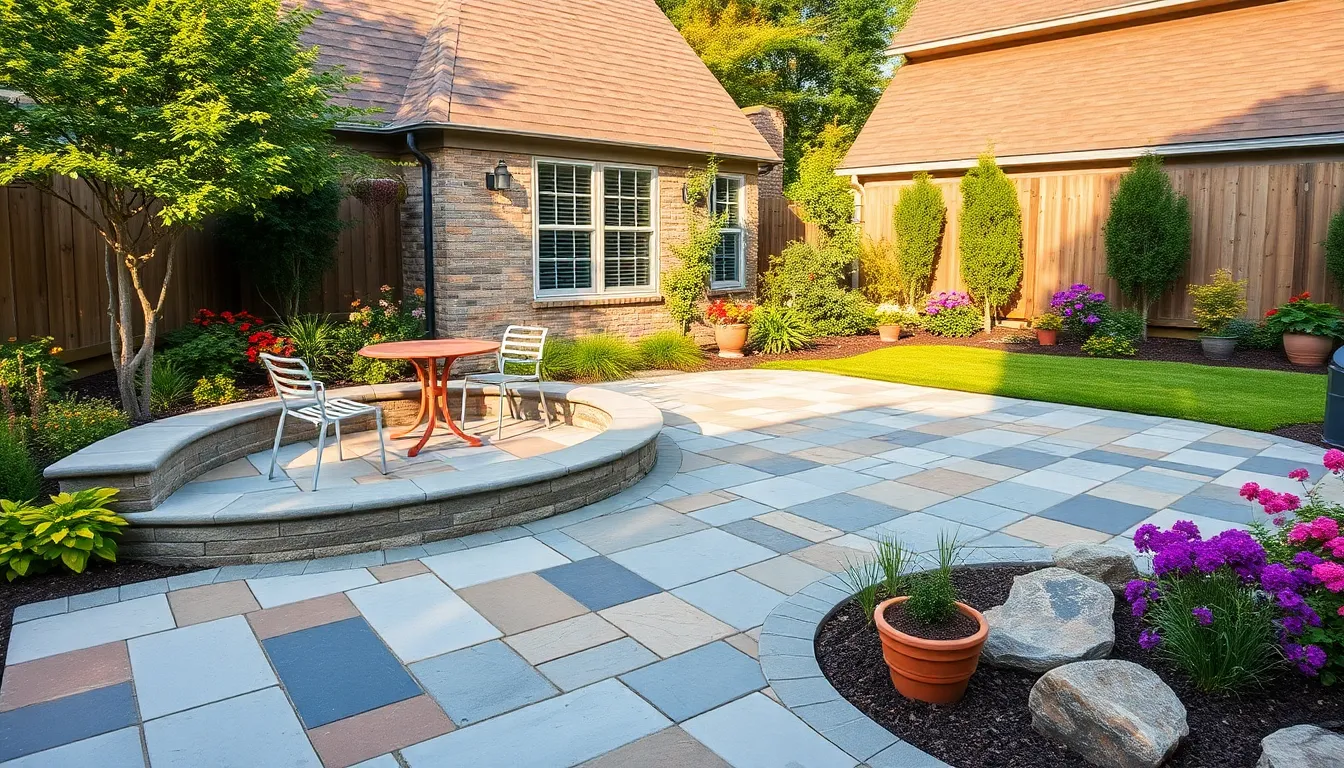
Selecting the right paver materials forms the foundation of your backyard transformation. We’ll explore three distinct material categories that offer unique benefits for creating stunning outdoor spaces.
Natural Stone Pavers
Natural stone pavers deliver timeless elegance with their distinctive textures and rich color variations. Popular options include slate, flagstone, granite, and limestone, each bringing unique characteristics to your outdoor space. These materials provide exceptional durability while creating a natural aesthetic that seamlessly blends with outdoor landscapes.
Irregular shapes create a rustic, organic feel that’s perfect for garden paths or patios seeking an earthy appeal. The unique textures and colors found in natural stone can’t be replicated, ensuring your patio becomes a one of a kind focal point. Stone pavers work exceptionally well in traditional and cottage style backyards where natural elements take center stage.
Maintenance requirements include periodic sealing and care to prevent staining and weathering. Natural stone typically requires a higher investment compared to other paver options, but the longevity and sophisticated appearance justify the cost for many homeowners. We recommend consulting with professionals for proper installation to maximize the lifespan of your natural stone investment.
Concrete Paver Varieties
Concrete pavers offer versatility through many shapes, sizes, and colors that accommodate any backyard style. These cost effective alternatives to natural stone provide easier installation and maintenance while delivering impressive visual results. Modern manufacturing techniques allow concrete pavers to convincingly mimic natural stone or brick appearances.
Pattern options include herringbone, basketweave, and running bond designs that create visual interest across your patio surface. Customized designs become possible when mixing different concrete paver sizes and colors to complement your home’s architecture. We’ve seen homeowners successfully match their concrete pavers to existing hardscape elements for a cohesive outdoor design.
Slip resistant surfaces and exceptional durability make concrete pavers suitable for high traffic areas like patios and walkways. Installation efficiency increases with concrete pavers due to their uniform dimensions and lightweight properties. The wide range of available colors and textures ensures you’ll find options that perfectly match your design vision without exceeding your budget.
Permeable Paver Answers
Permeable pavers support sustainable water management by allowing water to pass through the surface and reduce runoff. These environmentally conscious options promote groundwater recharge while preventing pooling and flooding in your backyard. The design incorporates specially engineered blocks with gaps filled by gravel or grass materials.
Environmental benefits include reduced stormwater runoff and improved water filtration through natural processes. Permeable concrete and grass filled paver systems offer functional answers that don’t compromise on aesthetic appeal. We recommend these options for environmentally conscious homeowners who want to minimize their outdoor space’s ecological impact.
Stylish applications prove that sustainable choices can enhance rather than limit your design possibilities. Installation requires proper base preparation to ensure optimal water infiltration and long term performance. Many municipalities offer incentives for permeable paving installations, making these eco friendly options even more attractive for budget conscious projects.
Color Combinations and Border Treatments
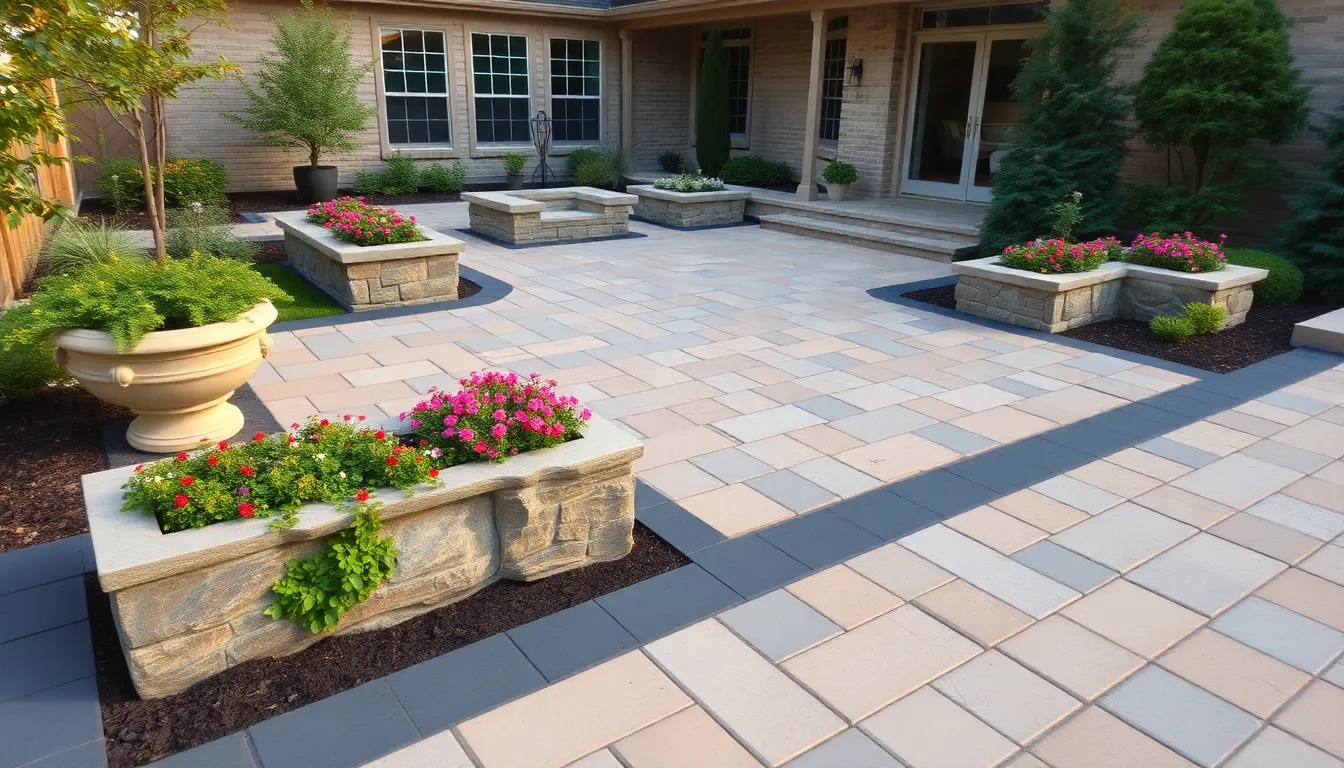
Selecting the right color palette and border design transforms your paver patio from ordinary to extraordinary. We’ll explore three proven approaches that enhance visual appeal while creating distinct outdoor character.
Contrasting Border Accents
Contrasting border accents define your patio space with striking visual frames that separate hardscape from landscaping. We recommend pairing warm-toned pavers like beige or light gray with darker borders in charcoal or brick red to create polished definition. This technique draws attention to your patio’s shape while establishing clear boundaries that enhance the overall design.
Bold color contrasts work exceptionally well when outlining geometric patterns or curved edges. We’ve seen homeowners achieve stunning results by combining cream-colored field pavers with deep brown border accents that echo natural wood elements. The contrasting approach creates immediate visual impact and helps your patio stand out as a distinct outdoor room.
Monochromatic Color Schemes
Monochromatic schemes blend different shades within the same color family to achieve harmonious elegance throughout your patio space. We often suggest gray palettes that range from pale silver to deep slate, creating subtle variation without overwhelming the visual senses. This unified approach makes your outdoor space feel cohesive and sophisticated.
Texture variation adds depth to monochromatic designs even when using single color families. We recommend mixing smooth and slightly textured pavers to create visual interest through surface contrast rather than color differences. The result is an elegant patio that feels both unified and ever-changing.
Mixed Tone Paver Blends
Mixed tone blends combine complementary colors to create vibrant surfaces that mimic natural stone variations. We typically intersperse tans, browns, and soft reds to achieve organic earthiness that softens rigid paver layouts. This approach works particularly well for rustic or Mediterranean backyard styles where natural warmth is desired.
Ever-changing color combinations eliminate the uniform appearance of single-tone installations while maintaining visual cohesion. We’ve found that mixed tone blends create more forgiving surfaces that hide dirt and wear patterns better than solid colors. The varied tones also complement diverse landscaping elements and architectural styles throughout your backyard space.
Integrated Landscape Features with Paver Patios
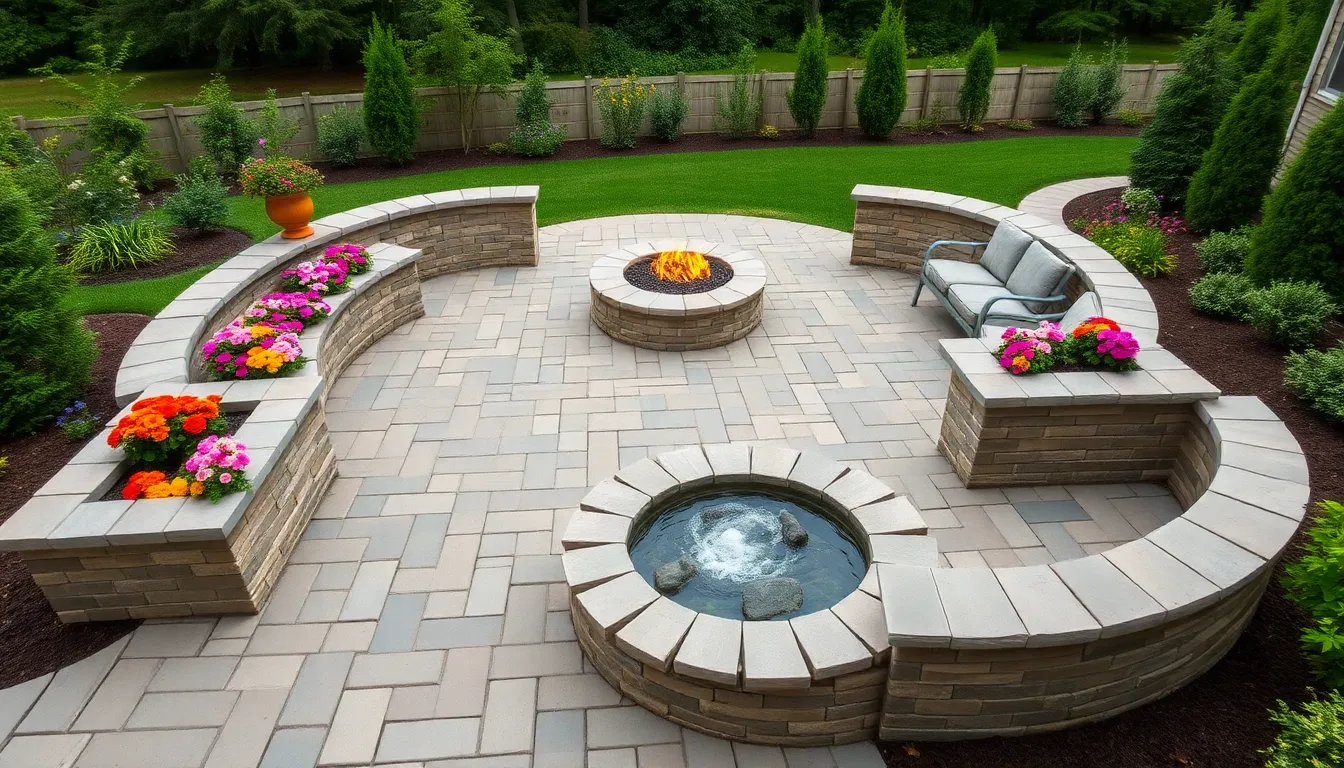
Transforming your paver patio from a simple outdoor surface into a cohesive industry masterpiece requires thoughtful integration of natural and architectural elements. We’ll explore how vertical elements like planters and garden walls can add elegance while building up your patio area with step treads and retaining walls creates distinct zones for different outdoor activities.
Built-In Planter Boxes
Built-in planter boxes seamlessly blend with paver patios to create stunning visual continuity throughout your outdoor space. These integrated planters eliminate the need for separate containers while providing permanent homes for flowers, herbs, or small shrubs that complement your patio design.
Designing planter boxes to match your paver materials ensures a cohesive aesthetic that feels intentional rather than added as an afterthought. We recommend constructing planters using the same materials as your patio borders or selecting complementary colors that enhance your overall design scheme.
Strategic placement of built-in planters can define different patio zones without creating harsh divisions between spaces. Consider positioning planters along patio edges to soften the transition between hardscape and industry or creating interior planter islands that serve as natural conversation focal points.
Fire Pit Integration
Fire pit integration transforms your paver patio into a year-round gathering destination that extends outdoor living well into cooler months. Central placement of fire features creates natural seating arrangements that encourage intimate conversations and social connections around the warming flames.
Safety considerations become paramount when incorporating fire pits into paver designs, requiring non-slip pavers around the fire area and proper clearance from combustible materials. We suggest using specialized fire-resistant pavers or creating dedicated fire pit zones with appropriate safety buffers built into your patio layout.
Surrounding your fire pit with complementary seating walls or built-in benches maximizes functionality while maintaining design cohesion throughout your patio space. These integrated seating answers eliminate the need for separate furniture while providing permanent gathering spots that won’t shift or blow away during storms.
Water Feature Incorporation
Water feature incorporation adds tranquil sounds and movement that transform your paver patio into a peaceful retreat from daily stresses. Small fountains, decorative ponds, or bubbling water elements create ambient noise that masks neighborhood sounds while providing visual interest throughout the seasons.
Designing water features to complement your paver materials ensures seamless integration rather than competing focal points that fragment your outdoor design. We recommend selecting water feature materials that echo your paver colors or textures to maintain visual harmony across your entire patio space.
Strategic water feature placement can help delineate different patio areas while improving both functionality and aesthetic appeal of your outdoor environment. Consider positioning water elements at transition points between patio zones or creating central water features that serve as natural gathering spots for outdoor entertaining.
Small Backyard Paver Patio Solutions
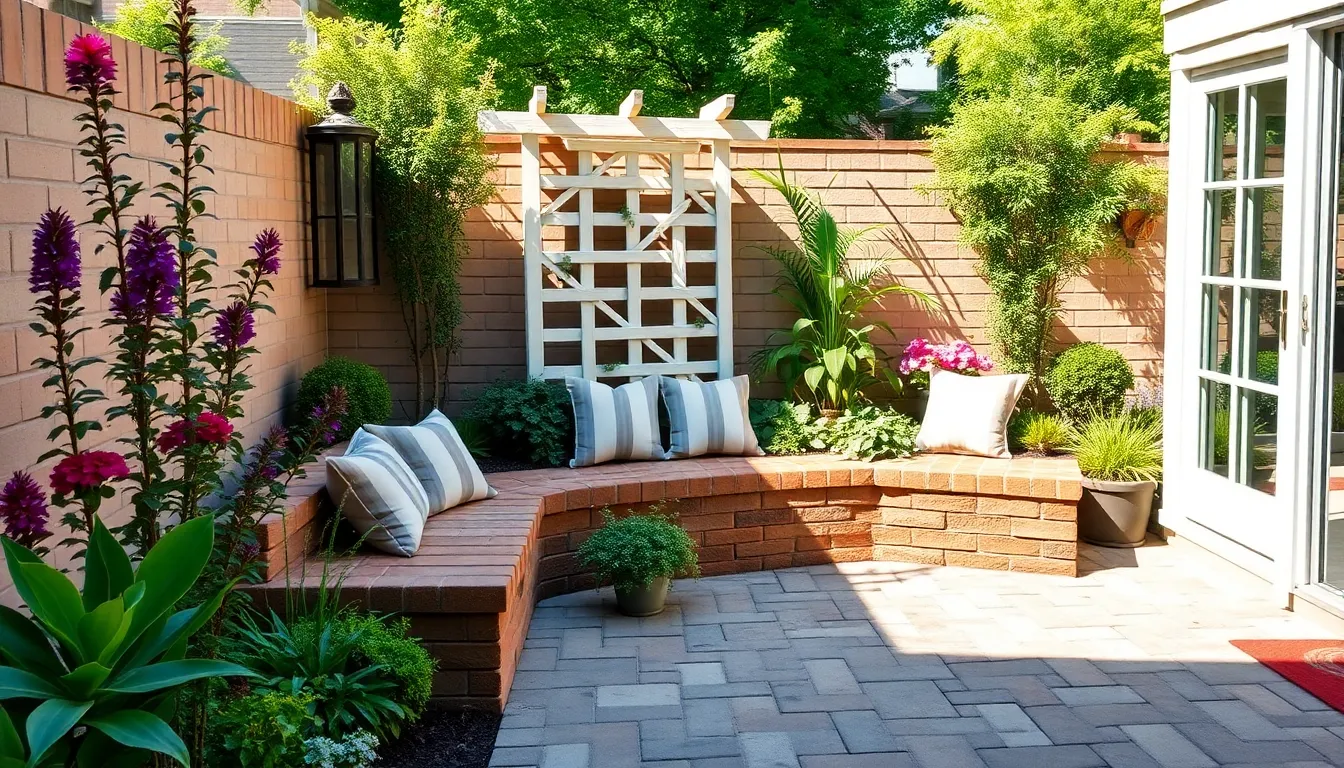
Small outdoor spaces present unique opportunities for creative paver patio designs that maximize every square foot. Strategic planning transforms limited areas into functional outdoor rooms through innovative layout techniques and smart material choices.
Compact Corner Designs
Corner spaces offer untapped potential for intimate paver patio retreats that transform neglected yard areas. We recommend creating cozy seating nooks using pavers to form defined corner zones that accommodate small gatherings without overwhelming the space. Built-in benches integrated with low retaining walls provide dual functionality while maintaining clean lines throughout the design.
Color and pattern choices in corner paver installations help delineate these intimate spaces from the rest of the yard. Contrasting paver borders create visual separation while maintaining flow with the overall industry design. Corner patios work exceptionally well for morning coffee spots or quiet reading areas where privacy and comfort take priority.
Narrow Space Layouts
Narrow patio areas benefit from linear layouts that visually expand the perceived space through strategic paver placement. Running bond patterns using rectangular pavers create the illusion of length while herringbone arrangements add visual interest without overwhelming tight spaces. We suggest selecting longer format pavers that emphasize the linear nature of narrow areas.
Multi-functional elements enhance narrow patio utility without creating visual clutter or physical congestion. Thin planter beds running parallel to the patio edge provide greenery while maintaining the streamlined aesthetic. Garden walls positioned alongside narrow patios create definition and can support climbing plants that add vertical interest.
Careful paver size selection and color contrast optimization enhance space perception in confined areas. Light colored pavers reflect more light and create an airy feeling while darker borders provide grounding elements that define the space boundaries.
Vertical Element Integration
Vertical features maximize small paver patio functionality by building upward rather than consuming valuable floor space. Raised planters, decorative pillars, and garden walls provide height and visual interest while serving practical purposes like privacy screening or plant support. These elements create distinct outdoor “rooms” within compact patio areas.
Retaining walls paired with step treads enable multi-level patio designs that optimize sloped or challenging terrain. We recommend incorporating these vertical elements during the initial paver installation to ensure proper drainage and structural integrity. Built-in seating walls provide additional functionality while maintaining the clean aesthetic of integrated design.
Trellises and vertical garden supports allow climbing plants to flourish without encroaching on patio floor space. Material coordination between vertical elements and paver selections creates cohesive design flow while layering different textures adds sophisticated visual appeal to small outdoor spaces.
Large Backyard Paver Patio Concepts
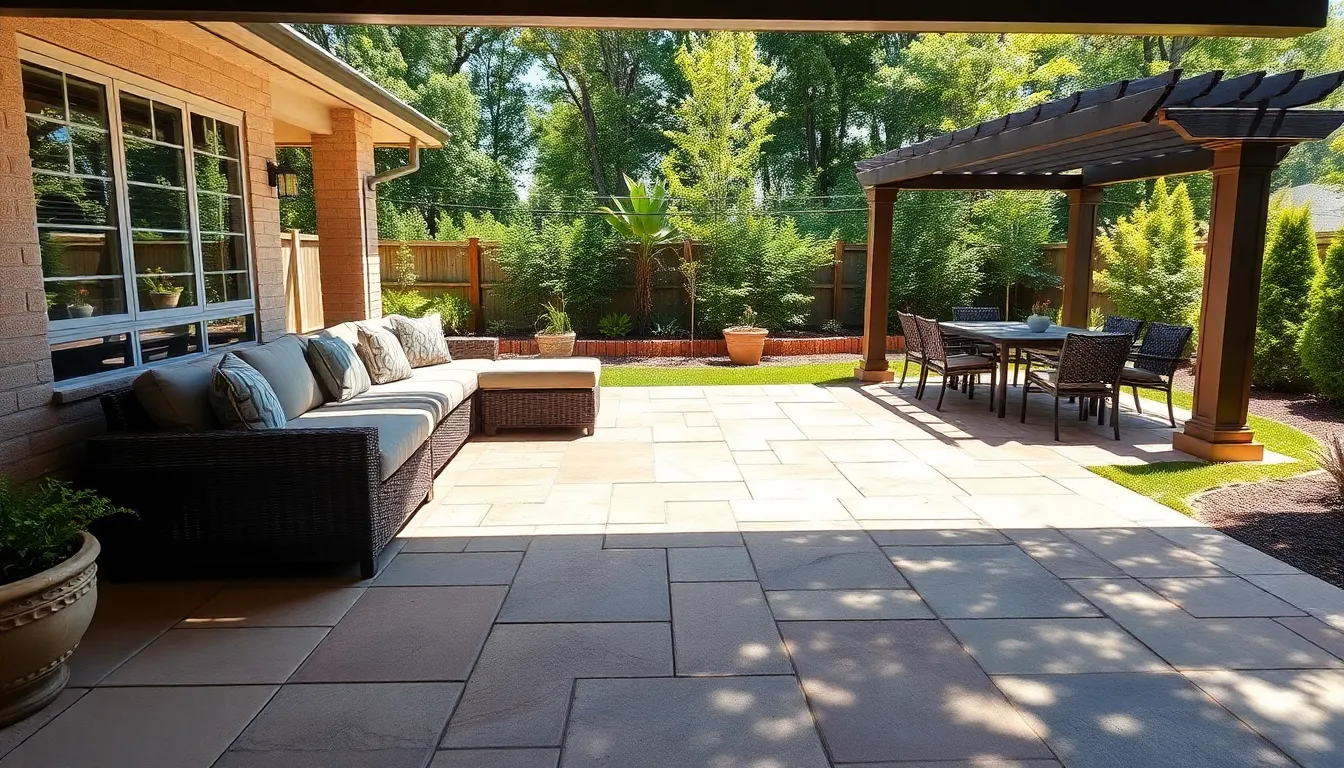
Large backyard patios present exciting opportunities to create sophisticated outdoor living spaces using pavers in various colors, sizes, and materials including concrete, brick, and natural stone. We can design these expansive areas to complement your home’s architecture while maximizing entertainment potential.
Expansive Entertainment Areas
Concrete and stone pavers in neutral tones like greys or oyster create elegant foundations for sophisticated outdoor living arrangements. We recommend sectional sofas, dining sets, and coffee tables that blend comfort with style across these generous spaces. Pergolas and awnings extend functionality by providing essential shade coverage over seating areas.
Natural stone materials like travertine offer seamless transitions from indoor floors to outdoor patios, effectively extending your living space. We suggest incorporating multiple furniture groupings to accommodate various social activities simultaneously. Large format pavers enhance the sense of scale while maintaining visual cohesion throughout the entertainment zone.
Multiple Activity Zones
Strategic zone planning transforms large paver patios into multifunctional outdoor rooms that cater to diverse activities:
- Dining zones accommodate formal meals and casual gatherings with dedicated furniture arrangements
- Lounge spaces feature comfortable outdoor furniture positioned for relaxation and conversation
- Walkway connections link garden features through thoughtfully designed paver paths
- Shaded retreats use pergolas or trellises to create quiet alcoves for reading or meditation
Pattern changes, color variations, and different paver sizes help define these zones without physical barriers. We design transitions between areas using subtle material shifts that maintain visual flow while establishing distinct purposes for each space.
Grand Scale Pattern Designs
Large pavers arranged in running bond or random patterns enhance spatial perception while adding compelling visual interest throughout the day. We use light and shadow interplay to create ever-changing effects that change as the sun moves across your patio.
Pattern selection significantly impacts the overall aesthetic, with geometric layouts emphasizing modern sophistication while irregular arrangements evoke natural stone appearances. Travertine patterns particularly excel at creating seamless indoor to outdoor transitions that expand perceived living space.
| Pattern Type | Visual Effect | Best Applications |
|---|---|---|
| Running Bond | Clean, elongated appearance | Modern, minimalist designs |
| Random Pattern | Natural, organic feel | Traditional, rustic settings |
| Large Format Grid | Bold, contemporary look | Entertainment focused areas |
We recommend combining pattern variations across different activity zones to create visual hierarchy while maintaining overall design cohesion throughout your expansive paver patio.
Maintenance-Friendly Paver Patio Ideas
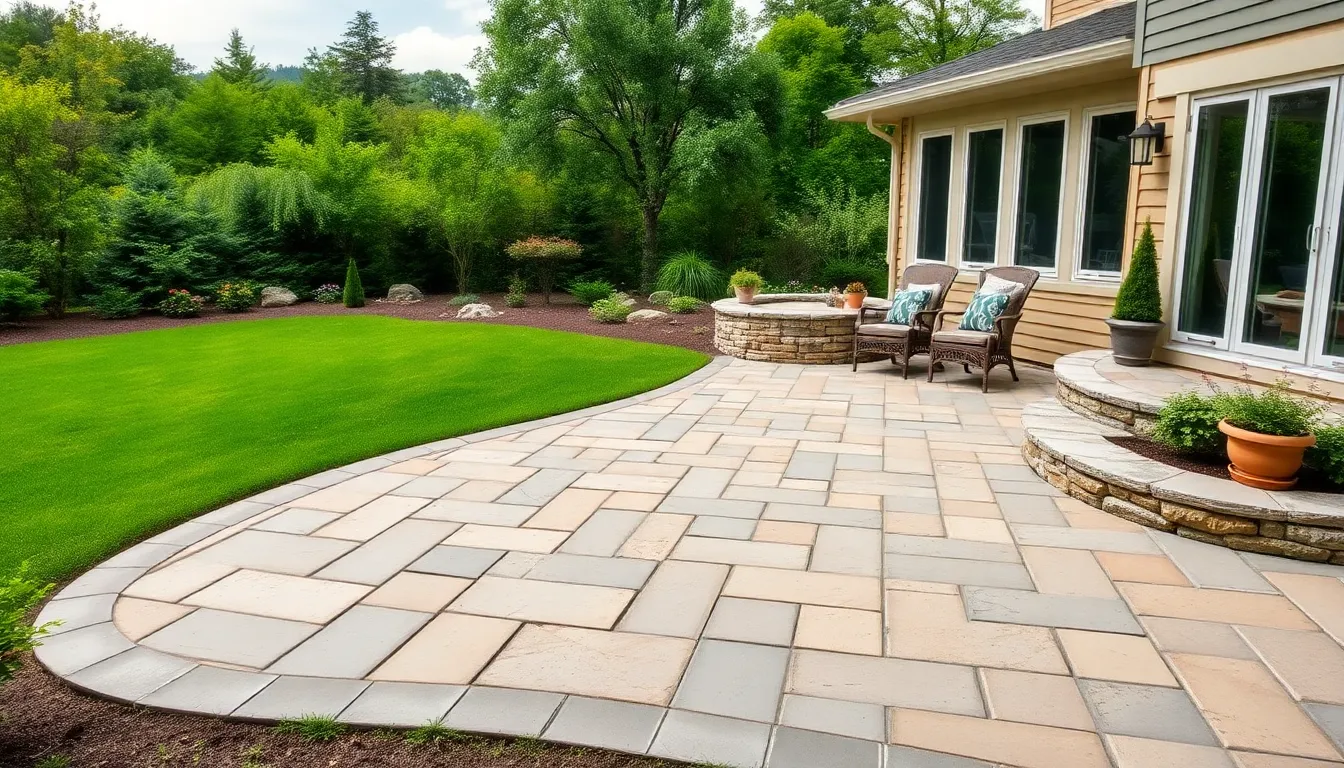
Creating paver patios that require minimal upkeep ensures you’ll spend more time enjoying your outdoor space and less time maintaining it. Smart design choices combine beauty with practicality to deliver lasting results.
Self-Draining Designs
Permeable layouts transform your paver patio into a natural drainage system that prevents water pooling. Installing pavers with permeable joint materials such as pea gravel or small slate rocks allows water to drain naturally between the stones, managing runoff effectively while keeping surfaces dry.
Proper base preparation creates the foundation for excellent drainage performance. Compacted gravel bases beneath pavers encourage water to filter through naturally, supporting drainage systems that prevent water accumulation and potential damage to your patio structure.
Natural filtration occurs when water moves through the permeable materials, reducing erosion around your patio edges. This self-draining approach eliminates the need for additional drainage systems while protecting your investment from weather-related damage.
Easy-Clean Surface Treatments
Smooth paver surfaces resist dirt buildup and simplify routine cleaning tasks. Natural stones and sealed concrete pavers offer finishes that can be easily cleaned with a standard hose or power washer, reducing the time needed for maintenance.
Sealing pavers enhances stain resistance and makes removing spills or accumulated dirt much easier. Applied sealants create protective barriers that extend your patio’s pristine appearance while simplifying ongoing care requirements.
Textured surfaces that balance slip resistance with cleanability provide practical answers for high-traffic areas. These specially designed paver surfaces prevent debris accumulation while maintaining safety standards for wet conditions.
Weed-Resistant Installation Methods
Polymeric sand joints create hardened barriers that block weed growth and prevent ant infestations. Unlike traditional loose sand that allows plants to take root, polymeric sand hardens upon wetting to seal joints effectively and maintain clean paver lines.
Industry fabric barriers installed beneath the paver base discourage weed seeds from growing up through your patio. This weed-resistant foundation allows proper drainage while preventing unwanted vegetation from compromising your patio’s appearance.
Regular maintenance schedules that include occasional reapplication of polymeric sand and surface cleaning further reduce weed establishment chances. These simple preventive measures protect your investment while maintaining the professional appearance of your paver patio installation.
Conclusion
We’ve explored countless ways to transform your backyard with stunning paver patios that suit every style preference and space constraint. From timeless brick patterns to cutting-edge geometric designs each option offers unique possibilities for creating your perfect outdoor retreat.
The beauty of paver patios lies in their adaptability – whether you’re working with a compact corner or an expansive backyard there’s a design solution that’ll maximize your space’s potential. Smart material choices and strategic planning ensure your investment delivers both immediate impact and long-term satisfaction.
Your dream patio is within reach. Start planning today and soon you’ll be enjoying a beautiful outdoor space that brings family and friends together for years to come.
Frequently Asked Questions
What are the main advantages of paver patios over concrete?
Paver patios offer superior versatility, durability, and design flexibility compared to concrete. They come in various materials, colors, and patterns, allowing for complete customization to match your home’s architecture. Pavers are also easier to repair if damaged, as individual pieces can be replaced without affecting the entire surface.
What are the most popular classic brick paver patterns?
The three most popular classic brick paver patterns are herringbone (offering maximum durability and visual interest), running bond (providing simple elegance with a clean linear look), and basket weave (creating traditional charm with a timeless grid-like appearance). Each pattern offers unique aesthetic and structural benefits.
How can I create a paver patio in a small backyard?
Maximize small spaces with compact corner designs, linear layouts for narrow areas, and vertical elements like raised planters. Use contrasting borders for visual separation, built-in benches for seating, and multi-functional elements. These strategies create intimate retreats while optimizing every square foot of available space.
What paver materials require the least maintenance?
Permeable pavers, sealed concrete pavers, and natural stone with proper installation offer the lowest maintenance. Choose self-draining designs, easy-clean surface treatments, and weed-resistant installation methods using polymeric sand joints and fabric barriers to minimize upkeep while maintaining long-lasting beauty.
How do I incorporate water features into my paver patio design?
Strategic placement is key when adding water features to paver patios. Ensure material harmony between the water feature and surrounding pavers, consider proper drainage and electrical requirements, and position features where they enhance rather than obstruct traffic flow. This creates tranquil focal points that add visual interest.
What are the best color combinations for paver patios?
Popular combinations include contrasting borders with neutral centers, monochromatic schemes using varying shades of the same color, and mixed tone blends that create visual depth. Choose colors that complement your home’s exterior and landscape while considering how they’ll look in different lighting conditions throughout the day.
How can I create different zones in a large paver patio?
Use pattern changes, color variations, and different paver sizes to define distinct outdoor “rooms.” Create separate dining areas, lounge spaces, and entertainment zones through strategic furniture placement, built-in elements like planters or fire pits, and varying elevation levels to establish clear functional boundaries.
What installation methods help prevent weeds in paver patios?
Install fabric barriers beneath the paver base, use polymeric sand for joints instead of regular sand, ensure proper compaction of base materials, and maintain adequate drainage. These weed-resistant installation techniques significantly reduce maintenance requirements and help preserve your patio’s appearance over time.

